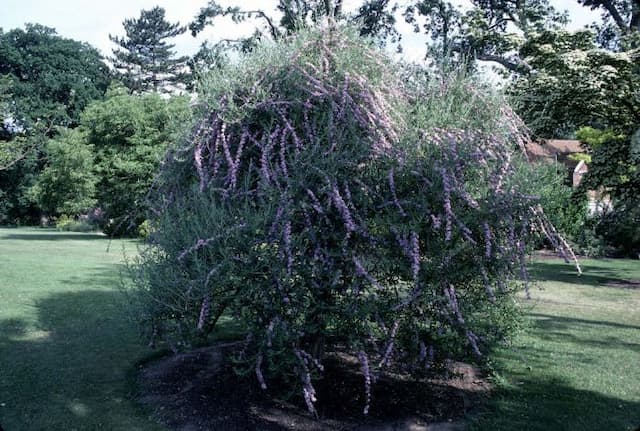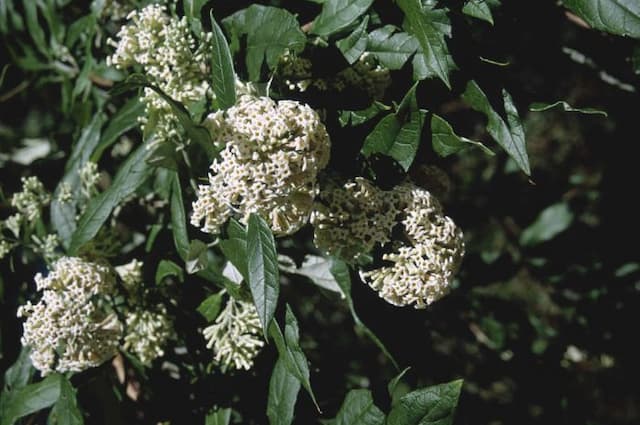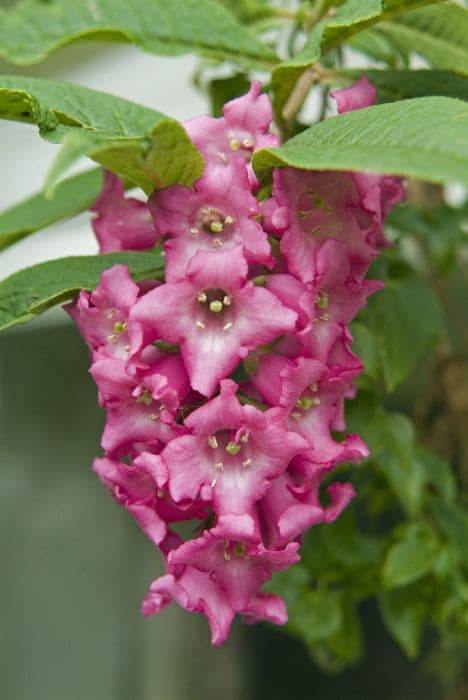Cape Fuchsia Phygelius × rectus 'Raspberry Swirl'

ABOUT
The plant commonly known as Cape Fuchsia 'Raspberry Swirl' showcases a striking appearance with a combination of vibrant colors and unique floral shapes. The plant produces tubular flowers that have a raspberry-pink hue with an eye-catching creamy yellow swirl running throughout the petals. These flowers are arranged in clusters, gracefully hanging down in a showy display, resembling little lanterns or elongated bells that attract attention from both humans and pollinators alike. Complementing the vivid flowers, the foliage of 'Raspberry Swirl' presents a dense arrangement of leaves that have a dark green color, providing an excellent backdrop that makes the pink of the flowers stand out even more prominently. The contrast between the foliage and the blooms adds to the overall ornamental value of the plant. The leaves themselves are somewhat lance-shaped, with a smooth or slightly serrated edge, and they are arranged opposite each other on the stems which adds to the plant's orderly yet full appearance. The combination of its striking flowers and lush foliage makes the Cape Fuchsia 'Raspberry Swirl' a popular choice for adding a splash of color and visual interest to gardens or landscaped areas.
About this plant
 Names
NamesFamily
Scrophulariaceae
Synonyms
Cape Fuchsia, Raspberry Swirl Cape Fuchsia
Common names
Phygelius × rectus 'Raspberry Swirl'.
 Toxicity
ToxicityTo humans
The Cape Fuchsia is not commonly known to be toxic to humans. However, as with many plants, it is advisable to avoid ingesting it since its effects are not well-documented and different individuals may have varying sensitivities to plant materials.
To pets
The Cape Fuchsia is also not widely recognized as a toxic plant to pets. However, the lack of documented toxicity does not guarantee safety, and it is generally recommended to prevent pets from consuming plants to avoid potential gastrointestinal discomfort or more serious reactions in sensitive animals. If ingestion occurs, monitor for signs of distress and consult a veterinarian.
 Characteristics
CharacteristicsLife cycle
Perennials
Foliage type
Semi-deciduous
Color of leaves
Green
Flower color
Pink
Height
3-4 feet (0.9-1.2 meters)
Spread
2-3 feet (0.6-0.9 meters)
Plant type
Shrub
Hardiness zones
7
Native area
South Africa
Benefits
 General Benefits
General Benefits- Attracts pollinators - The vibrant flowers of Phygelius × rectus 'Raspberry Swirl' are known to attract bees, butterflies, and hummingbirds, which are beneficial for pollination in the garden.
- Ornamental appeal - With its striking raspberry-and-cream swirl flowers, it adds visual interest and color to garden borders, beds, and containers.
- Drought tolerant - Once established, it has good drought tolerance, making it a suitable choice for xeriscaping or low-water gardens.
- Long blooming period - The plant has a long flowering season, from early summer to fall, providing extended color and garden interest.
- Ease of care - Phygelius × rectus 'Raspberry Swirl' is generally low-maintenance, requiring minimal care beyond basic watering and feeding.
- Resistant to deer - This plant is not a preferred choice for deer, which makes it a great option for gardens in areas with high deer populations.
- Versatile in use - Can be used in a variety of garden settings, such as perennial borders, rock gardens or as an informal hedge.
 Medical Properties
Medical PropertiesThis plant is not used for medical purposes.
 Air-purifying Qualities
Air-purifying QualitiesThis plant is not specifically known for air purifying qualities.
 Other Uses
Other Uses- Artistic inspiration: The unique coloration of the Cape Fuchsia can serve as a muse for artists and designers seeking vibrant tones for their work.
- Educational resource: Botany enthusiasts and educational institutions may use the Cape Fuchsia as an example to study hybrid plant characteristics and the results of crossbreeding.
- Photography subject: Its striking appearance makes the Cape Fuchsia a favorite subject for hobbyists and professional photographers alike, highlighting the beauty of nature.
- Theme gardens: The Cape Fuchsia can be incorporated into gardens designed around specific color schemes, such as a pink and white motif.
- Container gardening: Suited for container planting, Cape Fuchsia can add a splash of color to balconies, patios, and other small spaces.
- Hummingbird attractant: The tubular flowers of the Cape Fuchsia make it an excellent choice for gardens designed to attract hummingbirds.
- Butterfly garden component: The nectar-rich blooms are also attractive to butterflies, making it a suitable addition to butterfly gardens.
- Celebrations and events: Its vibrant flowers can be used as natural decorations for outdoor events and ceremonies during the blooming season.
- Seasonal interest: The Cape Fuchsia's flowers bloom in summer to fall, providing a long-lasting visual appeal throughout these seasons.
- Dye source: Historically, some plant species have been used to extract natural dyes, and the Cape Fuchsia's vivid flowers may hold potential for non-toxic fabric coloring processes.
Interesting Facts
 Feng Shui
Feng ShuiThe Cape fuchsia is not used in Feng Shui practice.
 Zodiac Sign Compitability
Zodiac Sign CompitabilityThe Cape fuchsia is not used in astrology practice.
 Plant Symbolism
Plant Symbolism- Resilience: This plant, commonly known as Cape Fuchsia, is robust and can thrive in various conditions, symbolizing the ability to persevere and adapt.
- Vibrancy: The 'Raspberry Swirl' variety, with its swirls of pink and raspberry colors, represents energy, exuberance, and the vibrant spirit of life.
- Attraction: Cape Fuchsia is known to attract hummingbirds, symbolizing allure, charm, and the capacity to draw in positivity and interest.
- Protection: In some cultures, fuchsias are believed to offer protection with their pendant-like blossoms, guarding against negativity and providing a sense of security.
 Water
WaterThe Cape Fuchsia should be watered thoroughly, allowing the top inch of soil to dry out between waterings. In the growing season, this often means watering approximately once a week with 1 to 1.5 gallons, depending on climate and environmental conditions. During the winter months, reduce watering to every other week, with around half a gallon, as the plant's growth slows down and it requires less moisture.
 Light
LightCape Fuchsia thrives best in full sun to part shade. It should be placed in a spot where it receives at least 4 to 6 hours of sunlight daily. Areas with bright, indirect sunlight for the remainder of the day are ideal for promoting vibrant blooms and healthy foliage.
 Temperature
TemperatureThe ideal temperature range for Cape Fuchsia is between 50 to 75 degrees Fahrenheit. It can survive minimum temperatures down to 20 degrees Fahrenheit but should be protected from frost. During the hot summer months, it's best to ensure the plant does not remain in temperatures exceeding 85 degrees Fahrenheit for prolonged periods.
 Pruning
PruningPrune Cape Fuchsia to maintain shape and encourage bushier growth. The best time for pruning is in late winter or early spring before new growth begins. Remove dead or damaged stems and cut back up to one-third of the plant's size annually to rejuvenate and promote healthy growth.
 Cleaning
CleaningAs needed
 Soil
SoilThe Cape Fuchsia 'Raspberry Swirl' prefers well-draining, fertile soil with a pH between 6.5 and 7.5. A mixture of loam, peat, and sharp sand or perlite is ideal, allowing for good drainage while still retaining necessary moisture and nutrients.
 Repotting
RepottingCape Fuchsia 'Raspberry Swirl' should be repotted every 2 to 3 years to refresh the soil and accommodate root growth. Choose a pot slightly larger than the current one to allow for continued growth.
 Humidity & Misting
Humidity & MistingCape Fuchsia 'Raspberry Swirl' thrives best in moderate humidity levels, avoiding environments that are too dry or too humid. A humidity level around 40-50% is generally suitable.
 Suitable locations
Suitable locationsIndoor
Place Cape Fuchsia 'Raspberry Swirl' in bright, indirect light indoors.
Outdoor
Plant Cape Fuchsia 'Raspberry Swirl' in partial shade and sheltered spot.
Hardiness zone
7-10 USDA
 Life cycle
Life cycleThe life of a Phygelius × rectus 'Raspberry Swirl', commonly known as Cape Fuchsia 'Raspberry Swirl', starts with seed germination, typically in a warm, moist soil condition where temperatures are moderate to warm. After germination, seedlings emerge and the young plants focus on vegetative growth, developing a rosette of leaves. As the plants mature, they enter the flowering stage, where they produce the distinctive long, tubular flowers that are pink and white, attracting pollinators such as hummingbirds and bees. After pollination, the flowers develop into small capsules containing numerous tiny seeds, completing the reproductive phase. Once seeds are dispersed, the plant either dies back in colder climates or may persist as a semi-evergreen shrub in milder conditions, depending on its perennial or sub-shrub nature. In subsequent growing seasons, the plant can either regrow from the base, if conditions are suitable, or the cycle begins anew from the germination of the dispersed seeds.
 Propogation
PropogationPropogation time
Spring to Summer
The Phygelius × rectus 'Raspberry Swirl', commonly known as Cape Fuchsia, is often propagated during late spring to early summer. The most popular method for propagating this plant is through softwood cuttings. This involves taking a cutting of new growth, which should be about 3-4 inches long, from the plant. The lower leaves are removed, and the cut end is often dipped in rooting hormone powder to encourage root development. The cutting is then inserted into a well-draining potting mix, watered gently, and covered with plastic to maintain humidity. It should be kept in a warm location with indirect light until roots develop, typically in a few weeks. Once rooted, the new Cape Fuchsia plant can be transplanted to a larger pot or directly into the garden.


![Butterfly bush [Berries and Cream]](/_next/image?url=https%3A%2F%2Fplants-admin.emdemapps.com%2Fimages%2Fplants%2F%2Fimages%2F604b650f667be.png&w=640&q=75)





